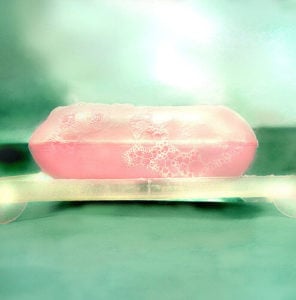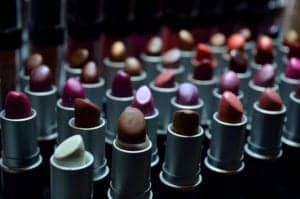When buying beauty products, many ethnic groups enjoy purchasing brands made for their culture because they cater to their specific needs for skin tone, hair texture and overall beauty aesthetic.
 Black people are no exception to this rule, and although they only make up about 13 percent of the U.S. population, it’s estimated that African American spending on personal care products accounts for nearly 22 percent of the $42 billion-a-year market. So it could be suggested that African Americans buy and use more personal care products as a whole.
Black people are no exception to this rule, and although they only make up about 13 percent of the U.S. population, it’s estimated that African American spending on personal care products accounts for nearly 22 percent of the $42 billion-a-year market. So it could be suggested that African Americans buy and use more personal care products as a whole.
But Black people may need to take caution when choosing some beauty products marketed towards them, because according to research, 1 in 12 of their beauty and personal care products in the U.S. contains highly hazardous ingredients.
The information was obtained by the Environmental Working Group, which analyzed 1,777 products marketed towards African Americans. Many of the products were unsafe — less than 25 percent of beauty products marketed to Black women were considered safe overall and scored low on the potentially hazard scale. In comparison, 40 percent of brands and products marketed to the general public were deemed safe.
Related: Scientists Discover ‘Uncombable Hair’ Gene
Ingredients linked to hazards like cancer, hormone disruption, and developmental and reproductive damage were found in several African American-targeted beauty products. The worst offenders were hair relaxers, hair colors and bleaching products.
“If a Black woman is choosing products marketed to their demographic, they have fewer healthier options,” said Nneka Leiba, deputy Director of Research at the Environmental Working Group, a Washington-based nonprofit research organization.
Ranking Products for Safety and Toxicity
The various personal products and their ratings were added to the EWG Skin Deep Database, which ranked 64,000 cosmetic products on their safety and potential harm. Here was the summary of the potential toxicity of products marketed to African Americans, according to the database:
- Fewer than one-fourth of the products scored 1 or 2 (green) for low potential hazard.
- Seventy percent scored from 3 to 6 (yellow) for moderate potential hazard.
- Eight percent scored from 7 to 10 (red) for high potential hazard.
See how your favorite brands fared by clicking here to search the database.
The Good and the Bad

There were some winning personal products in the evaluation. Bar soaps, body oils, moisturizers and body washes were among the best and safest categories. They comprised the most green-scoring products, fewest red-scoring products and lowest average scores. The worst-scoring product categories were hair relaxers, which had an average score of 8.1, and hair color and bleaching products, which ranked second worst with a score of 7.9.
“There are formaldehyde releasers in hair dyes,” Leiba said. Formaldehyde, a known cancer-causing agent, is present in products across the entire beauty market, but “there are less products without them” for Black women, she said.
The most popular chemical hair straighteners marketed toward Black women and girls (and some men) are relaxers and texturizers. These products contain lye, which breaks down the chemical bonds in the hair, removing curls and straightening the hair for styling. But scientists have found that chemical hair straighteners have been linked to various types of baldness and uterine leiomyomata — which are noncancerous growths in the uterus. Among pregnant women, the use of straight perms have been linked to premature birth, low infant birth weight and other pregnancy- and birth-related problems.
More Women Are Embracing Natural Hairstyles and Products
As of late, the use of these harsh styling products has been on the decline.
Over the last ten years, there’s been a trend of embracing natural hairstyles (and natural product use) among African American women. In addition, there’s been an overall acceptance of natural-looking Black hairstyles in mainstream culture. And the proof is in the numbers. Market analysis firm Mintel estimates that sales of hair relaxers marketed to Black women dropped by close to 40 percent between 2008 and 2015.
 On the opposite end of the comb, sales for “natural hair” products, specifically shampoos, conditioners and other styling items, have surged. According to the EWG report, between 2013 and 2015 alone, there’s been a 27 percent increase in “natural” hair styling products. Those products now make up 35 percent of the Black hair care market.
On the opposite end of the comb, sales for “natural hair” products, specifically shampoos, conditioners and other styling items, have surged. According to the EWG report, between 2013 and 2015 alone, there’s been a 27 percent increase in “natural” hair styling products. Those products now make up 35 percent of the Black hair care market.
However, many “natural” products still contain dangerous ingredients. Laboratory testing on lotions, conditioners and creams commonly used by Black women revealed estrogenic or anti-estrogenic activity, which meant the products mimicked the effects of the hormone estrogen.
“We don’t want people to assume that because they are choosing a natural product,” Leiba said, “that they are not choosing harmful products.”
Check the Label for These Ingredients
In addition to formaldehyde and lye, other toxic ingredients found in the products marketed to African Americans include:
- Retinyl palmitate — This ingredient is a form of vitamin A linked to skin cancer when exposed to sunlight. It is often found in concealers, foundations and lipsticks.
- Parabens — Parabens are hormone disrupting chemicals that are commonly used as preservatives in personal care products, pharmaceuticals and foods, and the risk of parabens increases with accumulated use. The long-chain variety — that would appear in your products as butylparaben, isobutylparaben, propylparaben and isopropylparaben — are more strongly linked to hormone disruption than the shorter-chained parabens, which were found in most products. Other health risks associated with long-chain paraben exposure include diminished fertility, lowered thyroid hormone levels and other reproductive problems.
- Fragrance — The vague ingredient “fragrance” posed the most concern in EWG’s study because it was found in more than half of the products investigated. And it’s not a single component, but instead an unknown mixture of chemicals slapped with an umbrella term. “Fragrance” can include more than 3,000 ingredients that are not disclosed to the public. All products that contained “fragrance” scored low or worse with Skin Deep because fragrance mixtures have often been linked to skin sensitizers, allergens, hormone disruption and phthalates. Phthalates are a group of chemicals used to make plastic more flexible and harder to break. They can also cause harm to the lungs, reproductive system and developing testes in fetuses.
Think Twice about Your Beauty Purchases
There’s been a worldwide cultural shift to healthier lifestyle choices from food and diet selections to health and fitness options, so personal products should be no exception. But, unfortunately, the EWG says, “the law doesn’t require cosmetic companies to share their safety information including adverse events.”

Leiba believes that informed consumers can influence companies to re-evaluate their products to make them safer and more consumer-friendly.
“This report will help push the companies that make these products marketed to Black women,” she said. “We want to empower all demographics.”
Researchers also hope that the people buying these products will use the findings in the Skin Deep database to learn more about the ingredients in their favorite brands. This can help them make informed decisions about which products are most important to their lifestyle, which will also allow consumers to mix and match what products they want to use and when they want to use them.
“What you choose to bring into your home is a very personal choice,” Leiba said, adding that the goal is not to dictate what people should and shouldn’t buy, but rather to help them perceive their risk. “You can still relax your hair (if you want), but maybe then avoid use of your lipstick if it scores badly.”
Related: Beauty Mirrors Have Officially Entered the Tech Age
Ronke Idowu Reeves is a writer and journalist who hails from Brooklyn, NY. Her news and entertainment stories have appeared on WABC-TV-New York, Fox News Channel, VH1, BET.com plus in Sundance Film Festival’s Sundance Daily Insider and People Magazine.


![How To: ‘Fix’ Crepey Skin [Watch]](https://cdn.vitalupdates.com/wp-content/uploads/2017/05/bhmdad.png)












